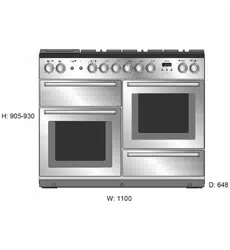Loading ...
Loading ...
Loading ...

12
Power Sharing Zones (Fig. 2.8)
Power sharing is taking the power from the adjacent zone.
For example, if zones C, D and E (Fig. 2.8) are set to power
level 9, or set to Power Boost (P) the power level in D or E will
adjust in the order it was switched on.
n
Avoid heating an empty pan. Doing so may damage
both the hob and pan.
Example 1: Set zone C to power level 9, switch on zone D
to power level 9 and then zone E to power level 9. After a
few seconds zone D power level will reduce to 7. Zone C will
remain at P or 9
Example 2: Set zone C to power level 9, switch on zone E
to power level 9 and then zone D to power level 9. After a
few seconds zone E power level will reduce to 6. Zone C will
remain at P or 9
Example 3: Set zone D and E to power level 9 and then zone
C to power level 9. After a few seconds zone E power level will
reduce to 6.
The same principle applies when using zone A and B. When
using zone A on Power Boost (P) and then switching zone B
to Power Boost (P), the power to zone A will reduce slightly.
n
This is a built-in safety device.
The Bridging-Zone Function
Zones A and B can be bridged, creating an area, ideal for use
with an induction griddle plate.
Note: The griddle plate should comprise of an induction
friendly, at bottom, large enough to cover zones A and B of
the hotplate heating area (Fig. 2.9).
DO NOT use zones C, D or E to heat the griddle plate
(Fig. 2.10).
To activate the dualzone function, simultaneously turn the
two left-hand controls completely clockwise (Fig. 2.11) and
hold until the [
] symbols appear in the centre of the hob
control display (Fig. 2.12). The temperature can then be
adjusted using the left-hand knob (Fig. 2.13).
Turn both knobs counter-clockwise to cancel the dualzone
function and return to normal operation.
n
DO NOT turn the two left-hand knobs individually
to heat the griddle plate. This can cause excessive
temperatures and damage the coating on the griddle
plate.
Fig. 2.8
Fig. 2.9
Fig. 2.10
Fig. 2.11
Fig. 2.12
Fig. 2.13
A
B
C
E
D
A & B linked
C, D & E linked
A
B
C
E
D
M
M
Loading ...
Loading ...
Loading ...
